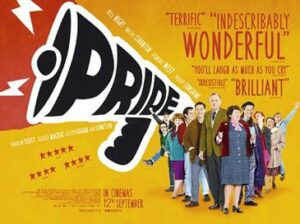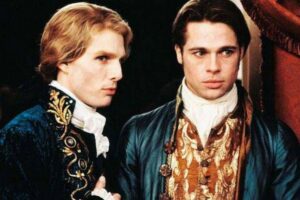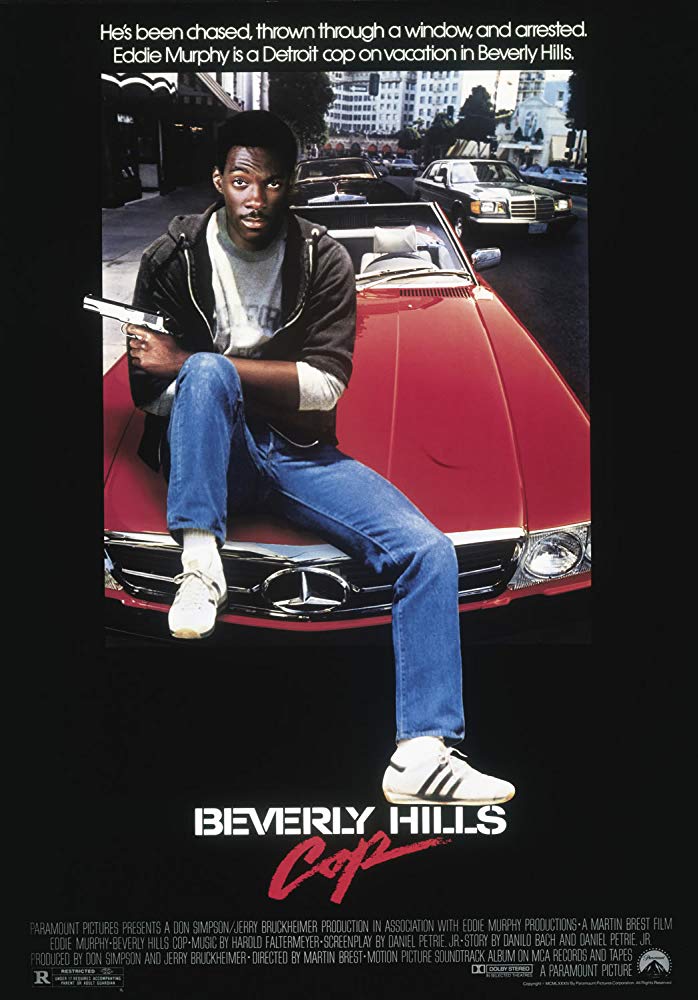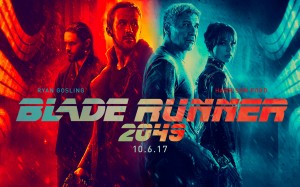For pride month this year, I am reviewing Matthew Warchu’s Pride. The film centres around a group of gay men (and a lesbian) and their struggle to raise money for a small Welsh village and the miners on strike there, whilst dealing with the rampant homophobia and the threat of the AIDS crisis looming overhead.
Considering the source material director Matthew Warchus manages to create a vibrant narrative, that balances the heavy subject matter with what I would call a very British approach to comedy. The blunt delivery to some lines, such as “Dai, your gays have arrived” or “We’re all off to have a big lez off” are delivered in such a way that you cannot help but laugh at them. This then paired with the juxtaposition of the group L.G.S.M (Lesbians and Gays Support the Miners) against the stone-faced Welsh miners which is repeatedly played up for laughs. What is important is the acceptance we see as these miners ask their new guests how to dance, or about the intricacies of what it means to be a lesbian.
Category Archives: Uncategorized
Dracula and Bram Stoker: The Coffin and the Closet by Matthew Peyton
On the whole, the figure of the vampire has been used to convey a variety of messages over the years since this creature of the night was first introduced into popular media. However, one theme that has seemingly been associated with the vampire is the fact that the vampire is often used to communicate themes of sexuality. There are of course examples of vampires engaging in heterosexual relationships, like the Twilight films for example, but the figure of the vampire is most commonly associated with homosexuality. Now this list of vampiric figures being linked to gay identities is quite extensive, from Interview with a Vampire (1994) to Dracula’s Daughter (1936) or Vampire Lovers (1970) so I aim to focus on one vampire in particular and his creator. Dracula and the writer Bram Stoker. Continue reading
Little Women: A modern twist on the original novel by Harriet Snowden
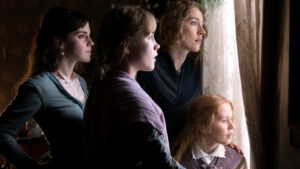 With an all-star cast, Greta Gerwig as director and Louisa May Alcott’s spectacular writing, the 2019 film was bound for success. From its distinct locations to gorgeous costumes, Gerwig was not only able to capture the novel in a way that was different, but has revolutionised it into something imaginable within the 21st century. Unlike some period pieces, the film contains lots of humour throughout; from the dance scene that took place between Jo and Laurie, to the sarcastic one liners from Streep’s character, helping to keep the film modern whilst being framed in the19th century. Continue reading
With an all-star cast, Greta Gerwig as director and Louisa May Alcott’s spectacular writing, the 2019 film was bound for success. From its distinct locations to gorgeous costumes, Gerwig was not only able to capture the novel in a way that was different, but has revolutionised it into something imaginable within the 21st century. Unlike some period pieces, the film contains lots of humour throughout; from the dance scene that took place between Jo and Laurie, to the sarcastic one liners from Streep’s character, helping to keep the film modern whilst being framed in the19th century. Continue reading
From Page to Screen by Henry King
We recently saw the release of Ben Wheatley’s adaptation of Daphne du Maurier’s seminal novel, Rebecca. The film is a Netflix production and boasts a cast including Armie Hammer as Maxim de Winter and Lily James as the Unnamed Protagonist. The dynamic between these two is fabulous and conveys the burgeoning romance upon which the film pivots with success. However, that is unfortunately about as far as the positives go for this flick.
Charlie’s Halloween Round-Up
There is no better way to get into the Halloween spirit than by watching some good old horror movies. After all, it is a pretty popular genre so there’s lots to choose from. If you are struggling on what movies to watch in time for Halloween this list should help. Don’t forget to let me know if you think something else should have take top-billing.
Reflection on Black History Month 2019: Review of The Last Tree By Grace Pheasey
In recognition of Black History Month 2019, I wanted to review The Last Tree written and directed by Shola Amoo. A few weeks ago, York St. John Film and Media students were given the opportunity to see a free screening of the film put on by York City Screen.
MA Spotlight – Aidan Dolby: ‘Hollywood Masculinities: Themes, Bodies, and Ideologies in 1980s Hybrid Action Cinema’
I am a Masters by research student at York St John University. My research focusses primarily on the areas of 1980s Hollywood cinema, Masculinity theory and Stardom studies, however I also have interests in American independent cinema, Documentary film and Tv, Transnational cinema and Hollywood cinema’s portrayal of urban and suburban America.
Suspiria (1977) Review: A Masterpiece of Italian Horror by Sam Cogdon
A Masterpiece of Italian Horror
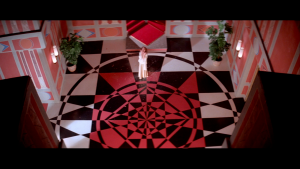
I was massively impressed by the artistic vision of this film, not only does it present a chilling supernatural horror narrative it accompanies it with glorious artistic direction which incorporates elements of Cubist and Abstract art to create a perfect setting for the film. Some elements of the production of the film I found to be reminiscent of Stanley Kubrick’s The Shining in that certain scenes of this film create the same eerie atmosphere as Kubrick does through symmetry and the uncanny to portray an unsettling atmosphere.
Blade Runner 2049 (2017, Denis Villeneuve)
On Tuesday the 10th of October, the second year, Imaginary Worlds: Researching Science Fiction class went to York City Screen to watch Denis Villeneuve’s Blade Runner 2049. Below you can find some 75-word reactions from students who came along and watched the film:
Welcome!
Hello and welcome to the York St John University Film and Media Studies blog!
If you want to submit work please email it to m.hall@yorksj.ac.uk with ‘Blog’ in the subject line!

